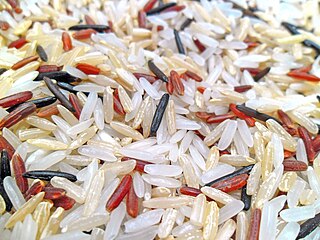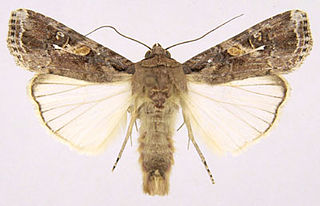Related Research Articles

Rice is the seed of the grass species Oryza sativa or less commonly O. glaberrima. The name wild rice is usually used for species of the genera Zizania and Porteresia, both wild and domesticated, although the term may also be used for primitive or uncultivated varieties of Oryza.

Eleusine coracana, or finger millet, also known as ragi in India, kodo in Nepal, is an annual herbaceous plant widely grown as a cereal crop in the arid and semiarid areas in Africa and Asia. It is a tetraploid and self-pollinating species probably evolved from its wild relative Eleusine africana.

The International Maize and Wheat Improvement Center is a non-profit research-for-development organization that develops improved varieties of wheat and maize with the aim of contributing to food security, and innovates agricultural practices to help boost production, prevent crop disease and improve smallholder farmers' livelihoods. CIMMYT is one of the 15 CGIAR centers. CIMMYT is known for hosting the world's largest maize and wheat genebank at its headquarters in Mexico.

CGIAR is a global partnership that unites international organizations engaged in research about food security. CGIAR research aims to reduce rural poverty, increase food security, improve human health and nutrition, and sustainable management of natural resources.

The International Crops Research Institute for the Semi-Arid Tropics (ICRISAT) is an international organization which conducts agricultural research for rural development, headquartered in Patancheru with several regional centers (Bamako, Nairobi and research stations (Niamey, Kano, Lilongwe, Addis Ababa, Bulawayo . It was founded in 1972 by a consortium of organisations convened by the Ford and the Rockefeller foundations. Its charter was signed by the FAO and the UNDP.
The cereal grain wheat is subject to numerous wheat diseases, including bacterial, viral and fungal diseases, as well as parasitic infestations.

Pyrenophora tritici-repentis (teleomorph) and Drechslera tritici-repentis (anamorph) is a necrotrophic plant pathogen of fungal origin, phylum Ascomycota. The pathogen causes a disease originally named yellow spot but now commonly called tan spot, yellow leaf spot, yellow leaf blotch or helminthosporiosis. At least eight races of the pathogen are known to occur based on their virulence on a wheat differential set.
CABI is a nonprofit intergovernmental development and information organisation focusing primarily on agricultural and environmental issues in the developing world, and the creation, curation, and dissemination of scientific knowledge.

Agriculture in Ghana consists of a variety of agricultural products and is an established economic sector, providing employment on a formal and informal basis. It is represented by the Ministry of Food and Agriculture. Ghana produces a variety of crops in various climatic zones which range from dry savanna to wet forest which run in east–west bands across Ghana. Agricultural crops, including yams, grains, cocoa, oil palms, kola nuts, and timber, form the base of agriculture in Ghana's economy. In 2013 agriculture employed 53.6% of the total labor force in Ghana.

Paspalum scrobiculatum, commonly called Kodo millet or Koda millet, is an annual grain that is grown primarily in Nepal and also in India, Philippines, Indonesia, Vietnam, Thailand, and in West Africa from where it originated. It is grown as a minor crop in most of these areas, with the exception of the Deccan plateau in India where it is grown as a major food source. It is a very hardy crop that is drought tolerant and can survive on marginal soils where other crops may not survive, and can supply 450–900 kg of grain per hectare. Kodo millet has large potential to provide nourishing food to subsistence farmers in Africa and elsewhere.

The fall armyworm is a species in the order Lepidoptera and one of the species of the fall armyworm moths distinguished by their larval life stage. The term "armyworm" can refer to several species, often describing the large-scale invasive behavior of the species' larval stage. It is regarded as a pest and can damage and destroy a wide variety of crops, which causes large economic damage. Its scientific name derives from frugiperda, which is Latin for lost fruit, named because of the species' ability to destroy crops. Because of its propensity for destruction, the fall armyworm's habits and possibilities for crop protection have been studied in depth. It is also a notable case for studying sympatric speciation, as it appears to be diverging into two species currently. Another remarkable trait of the larva is that they consistently practice cannibalism, despite its fitness costs.
Crop diversity or crop biodiversity is the variety and variability of crops, plants used in agriculture, including their genetic and phenotypic characteristics. It is a subset of and a specific element of agricultural biodiversity. Over the past 50 years, there has been a major decline in two components of crop diversity; genetic diversity within each crop and the number of species commonly grown.

Rajeev Kumar Varshney is an agricultural scientist, specializing in genomics, genetics, molecular breeding and capacity building in developing countries. Varshney is currently serving as Director, Western Australian State Agricultural Biotechnology Center; Director, Centre for Crop & Food Innovation; and International Chair in Agriculture & Food Security with the Food Futures Institute at Murdoch University, Australia since Feb 2022. Before joining Murdoch University, Australia he served International Crops Research Institute for the Semi-Arid Tropics (ICRISAT), a global agriculture R&D institute, for more than 16 years in different scientific and research leadership roles including Research Program Director for three global research programs– Grain Legumes, Genetic Gains and Accelerated Crop Improvement Program. He has the onus of establishing and nurturing the Center of Excellence in Genomics & Systems Biology (CEGSB), a globally recognized center for genomics research at ICRISAT that made impacts on improving agriculture and development of human resources in several countries including India, China, Kenya, Ethiopia, Tanzania, Nigeria, Ghana, Mali, Senegal, Burkina Faso, etc. Varshney holds Adjunct/Honorary/Visiting Professor positions at 10 academic institutions in Australia, China, Ghana, Hong Kong and India, including The University of Western Australia, University of Queensland, West Africa Centre for Crop Improvement, University of Hyderabad, Chaudhary Charan Singh University and Professor Jayashankar Telangana State Agricultural University.

Cajanus scarabaeoides is a flowering plant in the genus Cajanus. Of the 32 different species within the genus Cajanus, only one, C. cajan (pigeonpea), is cultivated. Cajanus scarabaeoides is the closest wild relative to C. cajan, and is one of the easiest wild species to cross with pigeonpea cultivars. C. scarabaeoides is found naturally in both temperate and tropical zones around the globe. This species has higher levels of drought tolerance, is found to have greater protein content, and has higher levels of resistance to insect pests compared to cultivated types. These genetic traits can be crossed with C. cajan to improve the crop's productivity. For subsistence farmers, this can reduce economic losses and drastically improve overall crop yield.
Maize lethal necrosis disease is a viral disease affecting maize (corn) predominantly in East Africa, Southeast Asia and South America, which was recognised in 2010. It is caused by simultaneous infection with two viruses, MCMoV and any of several Potyviridae.
Sorghum is an important staple crop for more than 500 million people in sub-Saharan Africa and South Asia, including many people in Nepal. In statistics collected from 1992-1994 about general millet, Nepal had an area of 0.21 million ha, with a yield rate of 1.14 (t/ha), and produced around 0.24 million tons of sorghum. The entirety of the crop is highly valued, with both the grain and the stem being utilized. The Terai region of Nepal tends to be more tropical which is ideal for the growth of sorghum. It tolerates hot climates better than maize or soybeans. For subsistence farmers, like those in Nepal, fertilizers are not necessary and the crop is frequently harvested by hand.
Spensa Technologies was a private company based in the Purdue Research Park in West Lafayette, Indiana that specialized in precision agriculture. The company, founded in 2009, was known for its ag-related technology, including automated pest sensors and software. It was acquired in April 2018 by DTN.
Phyllachora maydis is a plant pathogen causing ascomycete diseases in maize/corn, and is more commonly referred to as tar spot. Identified by the distinctive development of stroma, this pathogen in itself is of little economic importance in the production of corn. However, the accompanying fungal infection of Monographella maydis, identified by “fish-eye” lesions, was claimed to cause significant foliar damage and subsequently yield reduction. As of 2021 there is insufficient information about this pathogen and its management.
Gamaya is a Swiss company which provides drones equipped with hyper-spectral cameras for use in agriculture.

DeHaat is an Agritech company {headquartered in Patna, that offers end-to-end agricultural services to the Indian farmers.
References
- ↑ Tibbets, John H. (12 January 2018). "From identifying plant pests to picking fruit, AI is reinventing how farmers produce your food". eco-business. Retrieved 22 March 2018.
- ↑ Agus, Sydney; Vanian, Jonathan (7 September 2017). "6 'Change the World' Companies That Are Rising Stars". fortune.com. Retrieved 22 March 2018.
- ↑ Schiller, Ben (21 September 2017). "Machine Learning Helps Small Farmers Identify Plant Pests And Diseases". fastcompany.com. Retrieved 22 March 2018.
- ↑ Rollenhagen, Isabell (2 July 2015). "'Eine App für den grünen Daumen'". Archived from the original on 14 June 2021. Retrieved 19 February 2021.
- ↑ "Plantix expands market reach through acquisition of the Swiss startup Salesbee Startupticker.ch | The Swiss Startup News channel". www.startupticker.ch.
- ↑ Madslien, John (13 October 2017). "'Tell me phone, what's destroying my crops?'". bbc.com. Retrieved 22 March 2018.
- ↑ Haak, Steve (31 March 2017). "Die App Plantix erkennt kranke Pflanzen". wired.de. Retrieved 22 March 2018.
- ↑ Bansal, Manju (26 July 2016). "The Business of Climate Change". technologyreview.com. Retrieved 22 March 2018.
- ↑ Conroy, Gemma; Parletta, Natalie; Woolston, Chris (25 November 2020). "Germany's start-up scene is booming". Nature. 587 (7835): S106–S109. doi:10.1038/d41586-020-03319-9. S2CID 227175373 . Retrieved 10 December 2020.
- ↑ "1. Platz: Plantix". cebitaward.de. 2017. Archived from the original on 12 July 2018. Retrieved 22 March 2018.
- ↑ Jackiewicz, Zofia (8 September 2017). "U.S. Data-Driven Farming Prize Awards $300,000 for Innovative Agricultural Solutions in Nepal". datadrivenfarming.challenges.org. Retrieved 22 March 2018.
- ↑ "Plantix - An easy plant disease diagnostic & monitoring tool". worldsummitawards.org. 2017. Retrieved 22 March 2018.
- ↑ "Mobile App to Help Farmers Overcome Crop Damage". icrisat.org. 25 May 2017. Retrieved 22 March 2018.
- ↑ "Nepal Seed and Fertilizer Project". cimmyt.org. 2016. Archived from the original on 23 March 2018. Retrieved 22 March 2018.
- ↑ "CABI trials PEAT's smartphone app Plantix that identifies plant pests in the field". cabi.org. 2018. Retrieved 22 March 2018.
- ↑ Jain, Samiksha (26 May 2017). "AP Chief Minister N Chandrababu Naidu Launches Mobile App For Farmers In India". indianweb2.com. Retrieved 22 March 2018.